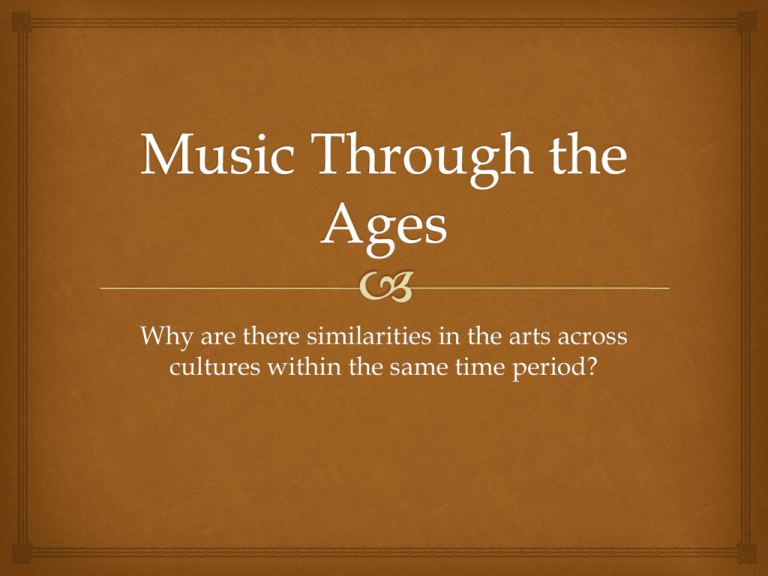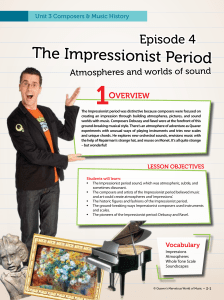Music Through the Ages
advertisement

Why are there similarities in the arts across cultures within the same time period? Composer Secular Opera Musical Concerto – Rondo - Commission - Vocabulary A person who writes music Music/art that is NOT religious A dramatic performance using music and NO speaking A play that combines acting, singing, and dancing A piece of music written for solo instrument and orchestra A musical form in which the A section repeats between 2 or more contrasting sections (ABACABA) A fee paid to a composer to write a piece for a certain person, group, or occasion Ages of Music Throughout history, and across cultures, musicians have created music for many purposes. Music is both sung and played, by groups and individuals. Music can be used for ceremonies, celebrations, festivals, and religious occasions. Music is used to accompany theater and dancing. Some music is just meant to be enjoyed as an art form. Musical Timeline Instruments: Then and Now Medieval/Renaissance Instruments Modern Instruments Instruments: Then and Now Medieval and Renaissance instruments include: Crumhorn – a double reeded woodwind instrument Lute – A string instrument, usually played by strolling minstrels (folk musicians) Regal – a keyboard instrument that is similar to the organ but can be carried Sackbut – a brass instrument with a slide Instruments: Then and Now Medieval/Renaissance instruments evolved into the instruments we use today, including: Oboe – a double reeded wind instrument Guitar – a string instrument used in many styles of music including folk, country, and rock Pipe Organ – a keyboard instrument often found in churches Trombone – a low pitched brass instrument with a slide instead of keys Music for the Stage Long before the invention of television or movies, people throughout the world combined music, dance, acting, and costumes to create a sense of excitement when telling stories. Music for the Stage One of the most famous types of dramatic performance with music is called an Opera., In an Opera, the actors tell the story entirely with song. There are no spoken words at all. Richard Wagner was one of the most famous composers of Opera. One of Wagner’s best known pieces is called “The Ring of Nibelung”, and is actually made up of four operas. Music Relates to Art In the Nineteenth century, artists and musicians began experimenting with their works. This style was called impressionism, a style in which artists gave the impression of a scene rather than a true image. Music Relates to Art Impressionist artists wanted to break with tradition These artists wanted to give an “impression” by paying attention to light, color, and mood, rather than the details of an image. One of the most famous impressionist artists is Claude Monet. Music Relates to Art Impressionist musicians were inspired by art, and wanted to borrow some of the artists ideas. One of the most famous impressionist composers was Claude Debussy. Claude Debussy used new ideas like the whole tone scale, which gave his music a dream-like feeling. The whole tone scale is made entirely of whole steps. Music For Events Music can be used to commemorate or celebrate an event Composers often write music for special events, in memory of people they admire, or for religious ceremonies. Sometimes, composers may receive commissions for their work. These are fees paid to a composer to write a piece of music for a certain group or event.








